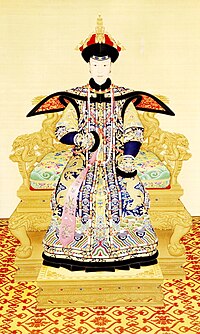|
Empress Xiaoxianchun
Empress Xiaoxianchun (28 March 1712 – 8 April 1748) of the Manchu Bordered Yellow Banner Fuca clan was an imperial consort of the Qing dynasty. She was the first wife of the Qianlong Emperor. LifeFamily background Empress Xiaoxianchun's personal name was not recorded in history.
Kangxi eraLady Fuca was born on the 22nd day of the 2nd lunar month in the 51st year of the reign of the Kangxi Emperor, which translates to 28 March 1712 in the Gregorian calendar. Yongzheng eraOn 3 September 1727, Lady Fuca married Aisin-Gioro Hongli, the Yongzheng Emperor's fourth son, as his primary consort and moved into the Palace of Eternal Spring in the western part of the Forbidden City. She gave birth on 3 November 1728 to her husband's first daughter, who died prematurely on 14 February 1730. On 9 August 1730, she gave to his second son, Aisin-Gioro Yonglian, who died due to smallpox on 23 November 1738. On 31 July 1731, she gave birth to Hongli's third daughter, Princess Hejing of the First Rank. Over time, Lady Fuca developed a wonderful relationship with Lady Gao, her husband's secondary consort since 4 April 1734. Qianlong eraThe Yongzheng Emperor died on 8 October 1735 and was succeeded by Hongli, who was enthroned as the Qianlong Emperor. On 23 January 1738, Lady Fuca, as the new emperor's primary consort, was instated as empress. She was assisted by the now Noble Consort Gao in managing the palace at large and caring for Empress Dowager Chongqing. In the Draft History of Qing, Empress Fuca is described as a respected and virtuous person who looked after the people in the palace, serving her role well. She was praised and favoured by her husband.[1] It is also said that she did not like spending money for her own aggrandizement and wore artificial flowers in her hair instead of expensive jewelry. The Qianlong Emperor once told her that their Manchu ancestors were too poor to make their own pouches from cloth and had to settle for simple deer hide instead, so she immediately made one for him. He was touched by the gift.[2] Empress Fuca took her duties seriously when it came to Confucian rituals. As head of the imperial harem, she supervised the other palace women when performing rituals. One of these was a rite concerning sericulture that was presided over by the empress. This rite, which had been practised since the Zhou dynasty, was gradually restored during the reign of the Qianlong Emperor. For the purpose of the rite, a sericulture altar was completed in 1744,[3] largely at her urging.[4] That year, she became the first empress consort of Qing to personally lead these rituals, making offerings of mulberry. In 1751, the whole rite was painted on four scrolls in her memory.[5] On 27 May 1746, Empress Fuca gave birth to the Qianlong Emperor's seventh son, Aisin-Gioro Yongcong. Her husband had high hopes for their son and named him crown prince shortly after his birth. However, Yongcong too died prematurely on 29 January 1748 due to smallpox, similar to Yonglian. DeathIn 1748, during one of the Qianlong Emperor's southern tours, Empress Fuca became seriously ill with a malarial fever and eventually died on 8 April, three months after Yongcong's death.[6] Her funeral was lavishly done. Her husband was deeply affected and did not take her death well. When he found out that two of his sons, Aisin-Gioro Yonghuang and Yongzhang, had not mourned for Empress Fuca as much as was expected, he issued a decree removing both of them from his list of potential successors to the throne. In addition, those court officials who shaved their hair, which was considered disrespectful as it was forbidden to do so throughout the mourning period, were either heavily punished or executed.[6] The bereaved Emperor wrote the poem Expressing My Grief after her death:
Titles
Issue
Gallery
In fiction and popular culture
See alsoNotes
References
|
||||||||||||||||||||||||||||||||||||||||||||||||||||||||||||||
Portal di Ensiklopedia Dunia



